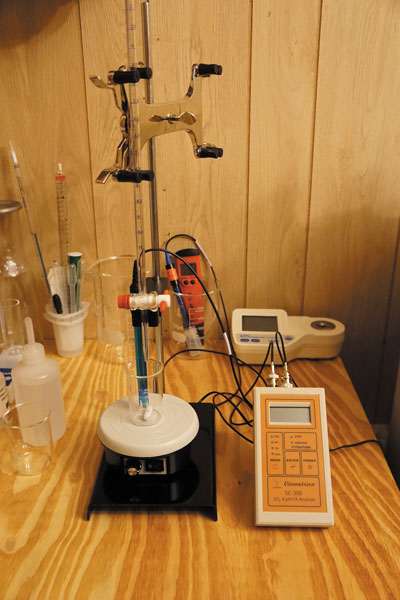Good for you for investing in a way to track your free SO2 (FSO2) levels. It’s one of the most important ways we can keep our wines safe. You can buy something like a Vinmetrica kit or send out samples monthly to a local wine analysis lab (like ETS here in Napa County), which is what I do for many of my own commercial wines, when the winery I’m working out of doesn’t have its own free-standing lab.
Yes, you just read correctly — monthly. FSO2 gets bound up quickly and is essentially used up in the wine as it reacts with wine components, especially when the wine is young. It’s only a portion of the FSO2 that is doing our antimicrobial and antioxidant work, so depending on the pH of your wine (high-pH/lower-acid wines need more sulfur dioxide to be protected from oxidation and microbial spoilage), you’ll want to keep your FSO2 hovering between 25–35 ppm all the time.

Like I said, it’s standard industry procedure for wineries to sample each lot for VA (volatile acidity) and FSO2 every month. If your VA is climbing and your FSO2 is under 20, it’s a good indication that you’ve got an active bacterial infection and will need to take quick action. You’re potentially lucky in that you’ve got all of your wine in smaller vessels, so if one vessel goes bad at least (hopefully!) the others won’t have. The downside to your small storage regime is that you’ve got a lot of vessels to sample and keep track of, and you might lose a lot of wine in the process.
So to my small-scale winemaking friends I say this: If you want to save wine, and not sample every single carboy, if your wine batch is all the same, you could potentially only open one of your carboys every month to test. Or you could try testing two different carboys every other month. The point is to try to get a handle on if your VA is climbing and your FSO2 is disappearing at an alarming rate. A normal, ideal rate of FSO2 consumption (loss) for wine that’s at least 6 months old would be losing 4–8 ppm FSO2 every month. It needs to be replaced monthly, too.
If your VA is climbing and your FSO2 is under 20, it’s a good indication that you’ve got an active bacterial infection and will need to take quick action.
I can absolutely guarantee that after 12–18 months of aging, with only one FSO2 check and adjustment in the beginning, your FSO2 will have completely disappeared, your wine will be unprotected, it might have turned to vinegar, and you’ll be very unhappy with the results (unless you were trying to make vinegar, then right on!). So yes, please test your FSO2 once a month, and if you can’t bring yourself to do that, then please do it every other month. Once you get a handle on how quickly the SO2 disappears (or gets turned from “free” to “bound” form), you’ll be better able to predict how often you need to adjust it and how much you need to add with every adjustment. For more on the forms of SO2 and the testing process, check out my fellow columnist Bob Peak’s piece covering this exact topic found in the October-November 2020 issue of WineMaker. Best of luck to you!




